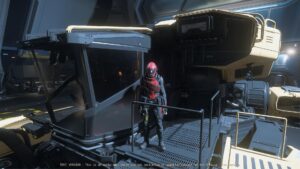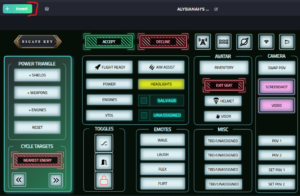[vc_row unlock_row_content=”yes” row_height_percent=”0″ override_padding=”yes” h_padding=”3″ top_padding=”2″ bottom_padding=”2″ back_color=”color-xsdn” overlay_alpha=”50″ gutter_size=”3″ shift_y=”0″][vc_column width=”2/3″][vc_column_text]Welcome to the first release of Alysianah Noire’s World of Star Citizen, a portal of my Star Citizen related content. This is the first iteration, reflecting the bare minimum of what’s planned. I’m excited to share this information with the community and hope you find it useful. More features will be added as time allows. Please keep in mind that this is a labor of love and not a full time occupation. I will address issues as I’m able. Keep your feedback constructive and polite.
I started down this road after becoming intrigued by the information presented in the official ARK Starmap. It was entertaining to explore what will become our physical universe and read the bits of lore it contained. I enjoy the lore for its storytelling aspects. I also endeavor to include lore and star system information in my content to enhance the context of the topic being discussed. The star system information is also very relevant to player careers, a huge focus for me in MMOs.
This site reflects a desire to have the star system information more accessible and open up opportunities to more easily add relevant lore from the Galactic Guides. I also tend to do research for articles on a mobile device and the ARK Starmap isn’t mobile device friendly.
WEBSITE CONTENT
- Starmap Matrix – list of all known star systems according to the ARK Starmap
- Star System Dossiers – star system information focused around specific player professions
- Universe Timeline – slideshow of Star Citizen universe historical timeline
- Ship Reviews – collection of ships I’ve reviewed
- Player Professions – collection of player professions I’ve reviewed
- Guides & Tutorials – discussions about game mechanics
- Articles – various articles I’ve written
- Casual Citizen – Casual Citizen YouTube series
- Site Updates – Information on updates to this website
STARMAP RELATED PAGES
- Daily retrieval of data from the official ARK Starmap – frequency will be increased as necessary
- Starmap Matrix page that shows all known star systems
- Designed to support easy scanning of high level system data
- Supports searching for a specific system
- Clicking column headings will sort the matrix by that attribute
- Clicking a star system name opens up the System Configuration Dossier for additional information
- Star System Dossier Pages
- Detailed System Configuration – detailed info on a single star system
- Gas Giants – star systems that have gas planets. Relevant to refueling career/ships.
- Asteroid Belts – star systems that have asteroid belts. Relevant to mining career.
- Green / Habitable – star systems that have green planets. Relevant to careers such as trade, import, export, etc. that rely on consumers.
- Fair Chance Act – star systems designated as protected for developing species. Relevant to science and potentially contraband/black market activities.
OVERVIEW OF STARMAP CONTENT
THE STARMAP MATRIX
- Lists all known star systems.
- Intended as a quick way of scanning basic star system information.
- Assists in identifying systems that may warrant a more detailed review.
- Designed to answer “which systems…” type questions
- Contain two stars?
- Belong to the UEE?
- Have high or low populations, economies and/or danger?
Use the following features to answer those types of questions:
- Each of the columns can be used to sort the data in the table by clicking the column name such as “System Name” or “Type” or “Population”, etc. The first click sorts A to Z. Clicking a second time sorts Z to A.
- You can search for a specific system by typing the name in the search bar located directly above the table. Type in a star system name and press Enter.
- If you want to see more details about a star system click it’s name. This will take you to the next page we’re about to discuss. The Detailed Star System Composition page.
- Population, Economy and Danger use a stoplight coloring metaphor. It’s a method for more quickly identifying good, poor and bad performance. This can be tricky when it comes to player professions since good and bad can be subjective. In this case I used it to denote volume – how much exists according to the starmap. High economy will be green. Low will be red. Conversely, high danger will be red and low will be green. So depending on your point of view, the color that means “ideal opportunity” may differ. If I want to find safe zones, I’m looking for green. If I want to find areas of high conflict, I’m looking for systems with red danger.
Caveat – Jump Points are not showing jump point sizes. I haven’t identified which attribute in the underlying data contains that designation. If anyone has looked at the data and knows, I’d love to include in the next iteration. Anyone at CIG wanna tell me? That would be fabulous!!
DETAILED STAR SYSTEM CONFIGURATION DOSSIER
- The intent of System Composition page is a deep dive into a single star system.
- Displays all of a star system’s known celestial bodies and jump points.
- Includes the descriptions and other useful information.
- Celestial objects are grouped by Type – Stars, Planets, Jump Points, Man Made, Asteroid Belts and Satellites. Anything else is currently group under MISC, such as Tamsa’s black hole.
- Retaining original data attribute names to avoid confusions since this data set is still evolving on CIG’s side.
- Next release will combine information gleaned from the Galactic Guides.
- Will include player contributed information when relevant player professions become available.
- Data available in each of the section tables will change over time, as I see which attributes are most meaningful on the whole. There’s more information available but I’m still sifting through it. This is a work in progress.
RECAP
Let’s recap before going further. I consider the Matrix view and System Composition pages to be the fundamental locations for investigating what we know about the physical Star Citizen universe. The matrix is the designed to support quickly scanning through the known star systems. The matrix table can be sorted by clicking on the column names. The System Composition is the deep dive view where you confirm that a star system will meet your needs.
MULTI-SYSTEM DOSSIER PAGES – PUTTING DATA IN TIGHTER CONTEXT
The more context you can incorporate into information, the more useful it becomes at answering specific questions. This idea manifests itself in what I’m calling Dossier pages. Dossiers combine ARK Starmap, lore and user contributed data for predefined scenarios, where each scenario represents a specific player careers such as mining, fuel collection, cargo hauling, etc.
From a data perspective, the career dossier pages combine the matrix and system composition view into a single page that shows multiple star systems. However, it doesn’t contain all of the star system information you’d find in the system composition page, which is a deep dive for a single system. Since they show multiple systems, it’s just enough celestial data and just the right lore and user contributed data, to assist in logistics planning.
All of the dossier pages behave similarly as far as available features. Let’s take a closer look by reviewing the Gas Giants Dossier page. What we discuss here holds true for the others as far as layout and features are concerned.
- Initially shows all star systems that meet the intent of that page
- Support multi-system filtering by star system name
- Supports multi government alignment by government name
- Planet information within each star system section can be sorted by clicking column headings
- Lists the jump points associated with all systems currently displayed to help identify common pathing for route planning
- Jump Point table can be sorted by clicking column headings
Experiment and provide feedback using the comments section of this post. Enjoy![/vc_column_text][/vc_column][vc_column column_width_percent=”100″ back_color=”color-zsdf” overlay_alpha=”50″ gutter_size=”3″ medium_width=”0″ shift_x=”0″ shift_y=”0″ z_index=”0″ width=”1/3″][vc_column_text]KNOWN ISSUES
- Jump Point sizes not available in this release. Need to identify which attribute in the data corresponds to the sizes
- May need to refresh page if you resize your browser after initial loading of the page’s data
- Dossier Pages – Select Star System and Select Government can’t be used simultaneously. For now it’s one or the other
Please leave feedback and issues found in the comments thread below. Thanks![/vc_column_text][/vc_column][/vc_row]




Welcome to release 1.0 of Aly’s World. Please leave comments, feedback, questions and information on issues encountered in this comments thread. Thanks!
Hey, I noticed the site doesn’t currently have much in the way of location images / art / footage etc and would be happy to provide you with an extensive list I’ve compiled of this stuff as it’s been dispersed over the last three years if that would be of use. It’s by no means comprehensive but I’ve been trawling old sources for more.
Thanks for the offer. I’ll hold on to your information. I’ll be working on adding images and charts after I integrate Galactic Guide lore information which is release 3.0. Priority for now is getting more of the basic data I have planned live, then enhancing the visual aspects afterward.
Cool, makes sense. 🙂
Oh also I was going to mention that there are Stretch Goal related Star Systems that aren’t on the Starmap (presumably because they’re undiscovered), plus 78 Leonis from the Constellation commercial which may or may not end up being real.
Correct there should be 100 but only 90 represented in the ARK Starmap data. That means at least 10 undiscovered and at least 13 missing jump points to discovered systems for which we have no way to gain access yet. This is why the starmap data is so fascinating to me. It’s chock-full of little hints about career activities. I wrote about it some here: http://www.redacted.tv/what-the-ark-starmap-tells-us-about-exploration/.
Since the 100 Systems stretch goal further stretch goals added the Pre-Launch Backer System, Tamsa, Tanga, Tano, UDS-2943-01-22, Kabal and Oretani – that makes 107.
Cool. The more the better 🙂
Well as a data guy for the Gov I have to say WOW. I love this site. It is crisp, clean and pleasing to my eyes. What tool did you use for the site build/template? Very nice and congratulations on the MVP. I hope you have time to keep it up to date and continuously add more content. Thank you for your hard work and effort!
Thank you, that’s really appreciated coming from someone who works with data. This is a WordPress site using a customized version of Uncode. It was a bit of a bear wresting it down to how I wanted pages to work but worth the effort. I absolutely intend to continue development. You can see from the releases page that 2 are already in the works. 1.1 is being worked on now to add more usability features. 2.0 is the next big one which will integrated Galactic Guide data at the celestial object level. That will take me quite some time just to get the mechanics in place followed by continuously updating the actual information. Beyond that I want to add visuals like the charts I’ve built by hand to accompany articles: http://www.redacted.tv/star-citizen-alien-races-the-banu/. I want some that are automated on the site for users to use when investigating the information. That’s not likely to happen until Q1 next year however. Stretch goal would be jump point planning. You’ve used the site to make your plans, now you need to plot your route. I’d love to get to that point.
Thank you Alysianah for the work you put into this site. In an effort to help improve the readability of search results, I found the following, which, if you follow the steps, should be reproducible.
01. Go to https://contentcreatorsunlimited.com/_habitable-planets/ .
02. In the drop down list titled, “Select Star System From the List”, select “Kilian”.
03. Notice in the results on the left hand side, there are no spaces between the words in the results, ergo, the output reads “KILLIANVIOSHA”, instead of “KILLIAN V IOSHA” (or maybe it should be “KILIAN V IOSHA, with one letter “L” in the middle? I defer to your good judgement).
Again, just wanted to point this out to improve readability of the results. Great job so far, and I look forward to the future of this site!
Regards,
John Kaye
That is actually the way the data is stored in the ARK Starmap – run together as a single word. I don’t alter or change the actual raw values. This keeps me in sync with the live data which will undoubtedly undergo many changes between now and release. This could be an error on their part that will be fixed. However, I don’t want to go down the rat hole of trying to interpret what they “meant” and do so incorrectly.
Automating the extraction of raw data means applying the same rules to every value of a specific type. For example, to improve readability and reduce the column width needed to display the data, I removed the star system name and hyphen from in front of Jump Points. It’s redundant when displaying the JPs alongside the star system. I also rounded the several digit size numbers to just 3 digits for display purposes. However, selective changes of the raw data would be difficult to apply.
Thanks for the feedback. It helps me verify what’s done on my end versus their end.
Locking Release 1.0 Thread. Please move comments to Release 1.1.
Thanks!